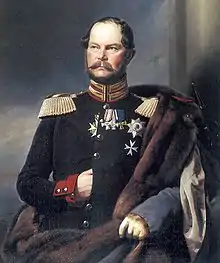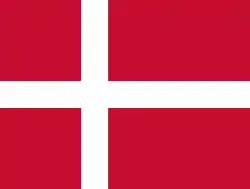Prince Charles of Prussia
Prince Frederick Charles Alexander of Prussia (German: Friedrich Karl Alexander; 29 June 1801 – 21 January 1883) was a younger son of Frederick William III of Prussia. He served as a Prussian general for much of his adult life and became the first Herrenmeister (Grand Master) of the Order of Saint John after its restoration as a chivalric order.[1] Nevertheless, he is perhaps remembered more often for his patronage of art and for his sizable collections of art and armor.
| Prince Charles | |||||
|---|---|---|---|---|---|
 Painting by Franz Krüger (1852) | |||||
| Born | 29 June 1801 Charlottenburg Palace, Brandenburg, Holy Roman Empire | ||||
| Died | 21 January 1883 (aged 81) Berlin, German Empire | ||||
| Burial | Ss. Peter and Paul, Wannsee, Berlin | ||||
| Spouse | Princess Marie of Saxe-Weimar-Eisenach | ||||
| Issue | Prince Friedrich Karl Louise, Landgravine of Hesse-Philippsthal-Barchfeld Anna, Princess Friedrich Wilhelm of Hesse-Kassel | ||||
| |||||
| House | House of Hohenzollern | ||||
| Father | Frederick William III of Prussia | ||||
| Mother | Louise of Mecklenburg-Strelitz | ||||
| Prussian Royalty |
| House of Hohenzollern |
|---|
 |
| Frederick William III |
|
Background
Charles was born in Charlottenburg Palace near Berlin, the third son of Frederick William III of Prussia by his wife Louise of Mecklenburg-Strelitz. He was named Frederick Charles Alexander at birth, but came to be known as Charles, because there were several other Fredericks in his family at that time. His father was already King of Prussia by the time of Charles' birth, and both of his elder brothers were to succeed to the throne, while his elder sister Charlotte would marry Tsar Nicholas I of Russia. Charles also had two younger sisters, Alexandra and Louise, and a younger brother, Albert.
Army career
Prince Charles entered the Prussian army in 1811 at the age of ten, with the rank of lieutenant in a regiment of the guards. In 1819, he became a member of the Prussian Staatsrat. In 1820, he became a major in the First Regiment of Foot Guards. In 1822, he became colonel of the 12th Infantry Regiment. In 1824, he was promoted to major general. In 1830, he commanded the 2nd Guards Division. He was further promoted to lieutenant-general in 1832 and general of infantry in 1844. He served as Inspector-General (1848) and as Generalfeldzeugmeister and chief of the artillery (1854).
Charles served as Governor of Mainz from 1864 to 1866. In 1852, he became Herrenmeister of the Order of Saint John (Bailiwick of Brandenburg).
Marriage and issue
On 26 May 1827 in Charlottenburg, Charles married Princess Marie of Saxe-Weimar-Eisenach, a daughter of Charles Frederick, Grand Duke of Saxe-Weimar-Eisenach and his wife Grand Duchess Maria Pavlovna of Russia.[2] Two years later, in 1829, Marie's younger sister Augusta would marry Charles' older brother, Wilhelm, the future Kaiser.
Charles and Marie had three children together:
| Image | Name | Birth | Death | Notes |
|---|---|---|---|---|
 | Prince Friedrich Karl Nikolaus of Prussia | 20 March 1828 | 15 June 1885 | Married Princess Maria Anna of Anhalt-Dessau; father of Louise Margaret, Duchess of Connaught and Strathearn. |
 | Princess Marie Louise Anna of Prussia | 1 March 1829 | 10 May 1901 | Married Alexis, Landgrave of Hesse-Philippsthal-Barchfeld |
 | Princess Maria Anna Friederike of Prussia | 17 May 1836 | 12 June 1918 | Married Friedrich Wilhelm of Hesse-Kassel |
The family lived in Wilhelmstrasse, opposite the residence of German Chancellor Otto von Bismarck.[3] In possession of great wealth and a great art collector, his palace contained many art treasures.[1] Charles was also a collector of rare weaponry, and carefully acquired and preserved knives, swords, daggers, rifles, pistols, and revolvers from many different countries and time periods.[3] As a result of his vast collection, one source stated his palace was "one of the most famous repositories of bric-a-brac in Europe...his collection of arms and armor is believed to know no rival save in the great State armories at Turin and Vienna".[1]
Death

Marie died in January 1877, only five months before what would have been the golden jubilee of their wedding. Although they had married for family and dynastic reasons, their marriage had been happy and harmonious, and they had been deeply attached to each other. After her death, Charles aged rapidly, and gradually grew infirm from ailments typical of advancing age. In 1882, his foot slipped while he was getting up from the dinner table, causing him to fall down heavily and fracture his left thighbone.[1] The fall and fracture accentuated his ailments, and it was reported that survival was unlikely.[1] He died in Berlin a few months later, on 21 January 1883, aged 81. His last words were "Long live the Emperor."[2]
At the time of his death, Charles was the only surviving brother of Emperor Wilhelm I. His death disrupted plans for the celebration of the silver wedding anniversary of his nephew, Crown Prince Frederick, as well as plans for a visit from the Prince and Princess of Wales to Berlin.[1][2]
Honours
He received the following decorations and awards:[4]
- German honours
.svg.png.webp) Prussia:
Prussia:
- Knight of the Black Eagle, 29 June 1811;[5] with Collar, 1819
- Pour le Mérite
- Grand Cross of the Red Eagle, with Oak Leaves and Swords
- Knight of the Prussian Crown, 1st Class
- Grand Commander of the Royal House Order of Hohenzollern, with Star and Swords
- Iron Cross, 1st Class
- Service Award Cross
 Ascanian duchies: Grand Cross of Albert the Bear, 16 December 1839; with Swords, 18 November 1864[6]
Ascanian duchies: Grand Cross of Albert the Bear, 16 December 1839; with Swords, 18 November 1864[6].svg.png.webp) Bavaria:
Bavaria:
- Knight of St. Hubert, 1853[7]
- Grand Cross of the Military Merit Order
 Brunswick: Grand Cross of Henry the Lion
Brunswick: Grand Cross of Henry the Lion.svg.png.webp) Baden:[8]
Baden:[8]
- Knight of the House Order of Fidelity, 1847
- Grand Cross of the Zähringer Lion, 1847
- Grand Cross of the Military Karl-Friedrich Merit Order, 1871
.svg.png.webp)
.svg.png.webp)
.svg.png.webp) Ernestine duchies: Grand Cross of the Saxe-Ernestine House Order, 1850;[9] with Swords
Ernestine duchies: Grand Cross of the Saxe-Ernestine House Order, 1850;[9] with Swords Hanover:[10]
Hanover:[10]
- Grand Cross of the Royal Guelphic Order, 1835
- Knight of St. George, 1839
 Hesse-Kassel: Grand Cross of the Golden Lion, 5 September 1841[11]
Hesse-Kassel: Grand Cross of the Golden Lion, 5 September 1841[11] Hesse and by Rhine:[12]
Hesse and by Rhine:[12]
- Grand Cross of the Ludwig Order, 29 June 1851
- Military Merit Cross for 1870-71, 16 March 1871
 Hohenzollern: Cross of Honour of the Princely House Order of Hohenzollern, 1st Class with Swords
Hohenzollern: Cross of Honour of the Princely House Order of Hohenzollern, 1st Class with Swords Mecklenburg:
Mecklenburg:
- Grand Cross of the Wendish Crown, with Crown in Ore
- Military Merit Cross, 1st Class (Schwerin)
- Cross for Distinction in War (Strelitz)
 Oldenburg: Grand Cross of the Order of Duke Peter Friedrich Ludwig, with Golden Crown and Collar, 16 May 1850[13]
Oldenburg: Grand Cross of the Order of Duke Peter Friedrich Ludwig, with Golden Crown and Collar, 16 May 1850[13].svg.png.webp) Saxe-Weimar-Eisenach: Grand Cross of the White Falcon, 15 December 1826;[14] with Swords
Saxe-Weimar-Eisenach: Grand Cross of the White Falcon, 15 December 1826;[14] with Swords.svg.png.webp) Saxony:
Saxony:
- Knight of the Rue Crown, 1846[15]
- Grand Cross with Swords, Order of Merit
 Schaumburg-Lippe: Military Merit Medal
Schaumburg-Lippe: Military Merit Medal Württemberg:[16]
Württemberg:[16]
- Grand Cross of the Württemberg Crown, 1841
- Grand Cross of the Military Merit Order, 30 December 1870
- Foreign honours
 Austrian Empire:
Austrian Empire:
- Grand Cross of St. Stephen, 1835[17]
- Military Merit Cross, with War Decoration
.svg.png.webp) Belgium: Grand Cordon of the Order of Leopold, 6 May 1853[18]
Belgium: Grand Cordon of the Order of Leopold, 6 May 1853[18] Denmark: Knight of the Elephant, 26 May 1853[19]
Denmark: Knight of the Elephant, 26 May 1853[19].svg.png.webp) French Empire: Grand Cross of the Legion of Honour, August 1867[20]
French Empire: Grand Cross of the Legion of Honour, August 1867[20].svg.png.webp) Kingdom of Greece: Grand Cross of the Redeemer
Kingdom of Greece: Grand Cross of the Redeemer.svg.png.webp) Kingdom of Hawaii: Grand Cross of the Order of Kalākaua, 1881[21]
Kingdom of Hawaii: Grand Cross of the Order of Kalākaua, 1881[21] Monaco: Grand Cross of St. Charles
Monaco: Grand Cross of St. Charles Netherlands:
Netherlands:
- Commander of the Military William Order, 25 August 1878[22]
- Grand Cross of the Netherlands Lion
.svg.png.webp) Ottoman Empire: Order of Osmanieh, 1st Class in Diamonds
Ottoman Empire: Order of Osmanieh, 1st Class in Diamonds Beylik of Tunis: Husainid Family Order, in Diamonds
Beylik of Tunis: Husainid Family Order, in Diamonds.svg.png.webp) Kingdom of Portugal: Grand Cross of the Tower and Sword, with Collar
Kingdom of Portugal: Grand Cross of the Tower and Sword, with Collar Russian Empire:
Russian Empire:
- Knight of St. Andrew, 25 June 1820
- Knight of St. Alexander Nevsky
- Knight of the White Eagle
- Knight of St. Anna, 1st Class
- Knight of St. Stanislaus, 1st Class
- Knight of St. George, 4th Class, 26 November 1869; 3rd Class, 22 October 1872
- Knight of St. Vladimir, 1st Class
.svg.png.webp) Kingdom of Sardinia: Knight of the Annunciation
Kingdom of Sardinia: Knight of the Annunciation.svg.png.webp) Siam: Knight of the Crown of Siam, 1st Class
Siam: Knight of the Crown of Siam, 1st Class.svg.png.webp) Spain: Knight of the Golden Fleece, 5 May 1865[23]
Spain: Knight of the Golden Fleece, 5 May 1865[23].svg.png.webp)
 Sweden-Norway: Knight of the Seraphim, 22 March 1873[24]
Sweden-Norway: Knight of the Seraphim, 22 March 1873[24].svg.png.webp) Two Sicilies: Grand Cross, Order of St. Ferdinand and Merit
Two Sicilies: Grand Cross, Order of St. Ferdinand and Merit
Ancestry
References
- "Prince Charles of Prussia", The New York Times, Berlin, 19 June 1882
- "Kaiser William's Brother Dead", The New York Times, Berlin, 22 January 1883
- "Prince Charles of Prussia", The New York Times, 8 February 1883
- Hof- und Staats-Handbuch des Königreich Preußen (1882-83), Genealogy p. 2
- Liste der Ritter des Königlich Preußischen Hohen Ordens vom Schwarzen Adler (1851), "Von Seiner Majestät dem Könige Friedrich Wilhelm III. ernannte Ritter" p. 16
- Hof- und Staats-Handbuch des Herzogtum Anhalt (1867) "Herzoglicher Haus-orden Albrecht des Bären" p. 16
- Hof- und Staats-Handbuch des Königreichs Bayern (in German). Königl. Oberpostamt. 1867. p. 10. Retrieved 15 July 2019.
- Hof- und Staats-Handbuch des Großherzogtum Baden (1873), "Großherzogliche Orden" pp. 59, 63, 73
- Staatshandbücher für das Herzogtum Sachsen-Coburg und Gotha (1884), "Herzogliche Sachsen-Ernestinischer Hausorden" p. 30
- Staat Hannover (1857). Hof- und Staatshandbuch für das Königreich Hannover: 1857. Berenberg. pp. 32, 64.
- Kurfürstlich Hessisches Hof- und Staatshandbuch: 1856. Waisenhaus. 1856. p. 11.
- Hof- und Staats-Handbuch des Großherzogtum Hessen (1879), "Großherzogliche Orden und Ehrenzeichen" pp. 10, 130
- Hof- und Staatshandbuch des Großherzogtums Oldenburg: für das Jahr 1872/73, "Der Großherzogliche Haus-und Verdienst Orden" p. 30
- Staatshandbuch für das Großherzogtum Sachsen / Sachsen-Weimar-Eisenach (1869), "Großherzogliche Hausorden" p. 11
- Staatshandbuch für den Freistaat Sachsen: 1865/66. Heinrich. 1866. p. 4.
- Württemberg (Kingdom). Statistisches Landesamt (1877). Staatshandbuch für Württemberg. Druck von W. Kohlhammer. pp. 21, 52.
- "A Szent István Rend tagjai" Archived 22 December 2010 at the Wayback Machine
- H. Tarlier (1854). Almanach royal officiel, publié, exécution d'un arrête du roi (in French). 1. p. 37.
- Jørgen Pedersen (2009). Riddere af Elefantordenen, 1559–2009 (in Danish). Syddansk Universitetsforlag. p. 468. ISBN 978-87-7674-434-2.
- M. & B. Wattel (2009). Les Grand'Croix de la Légion d'honneur de 1805 à nos jours. Titulaires français et étrangers. Paris: Archives & Culture. p. 510. ISBN 978-2-35077-135-9.
- The Royal Tourist—Kalakaua's Letters Home from Tokio to London. Editor: Richard A. Greer. Data: 10 March 1881
- "Militaire Willems-Orde: Preussen, Friedrich Karl Alexander Prinz von" [Military William Order: Prussia, Frederick Charles Alexander Prince of]. Ministerie van Defensie (in Dutch). 25 August 1878. Retrieved 14 June 2020.
- "Caballeros de la insigne orden del toisón de oro", Guía Oficial de España (in Spanish), 1882, p. 136, retrieved 14 June 2020
- "Sveriges statskalender" (in Swedish). 1877. p. 369. Retrieved 6 January 2018 – via runeberg.org.
External links
 Media related to Carl of Prussia at Wikimedia Commons
Media related to Carl of Prussia at Wikimedia Commons
Prince Charles of Prussia Born: 29 June 1801 Died: 21 January 1883 | ||
| Preceded by August Ferdinand, Prinz von Preußen |
Herrenmeister (Grand Master) of the Order of Saint John 1853–1883 |
Succeeded by Albrecht, Prinz von Preußen |
|}